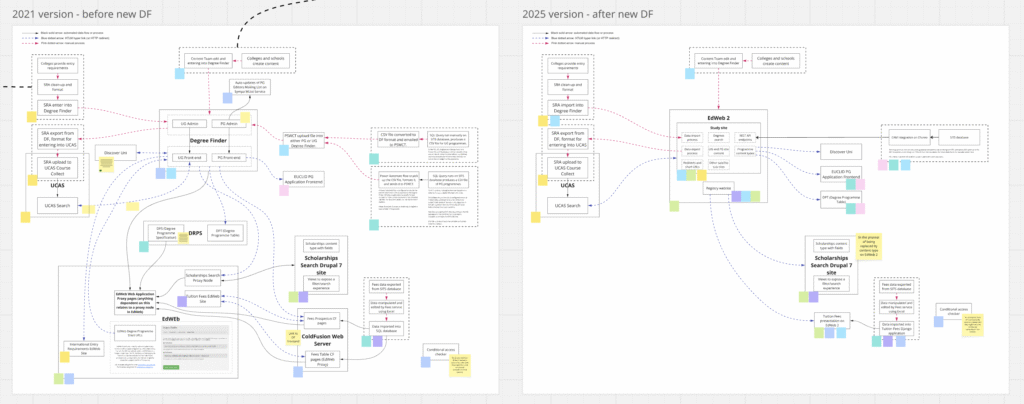Simplifying our systems and processes improves speed and efficiency
In 2021 I created a diagram of the people, processes and systems surrounding the Degree Finders to help inform our technical planning and communication to stakeholders. I’ve just updated the diagram for 2025 to reflect our new service. Comparing old with new really highlights how much our technology landscape has evolved and simplified.
What is the people, processes and systems diagram?
Put simply, it’s a map that I created to show all of the connections that either feed into the degree finder, or that the degree finder depends on.
- Systems: the different software applications that exist around the degree finder.
- Processes: the different processes that connect those systems, distinguishing between those that are automated and those that are manual. (It also shows where there are links between systems, even if those are simply hyperlinks on a webpage from one system to another.)
- People: the different team or teams that are involved in each system or process.
The result is a diagram that clearly showed the complexity and the tremendous number of interdependencies.
Having the original map was important to us as allowed us to visualise and communicate those key dependencies.
Throughout the project, I shared the diagram with collaborators and stakeholders. It helped me have more informed conversations with our development partners Manifesto and IS Website and Communications (who manage the EdWeb2 content management system) and with managers of services we depend upon like Student Systems.
We also were able to have more informed conversations with colleagues involved with Curriculum Transformation as they better understood the flow of content and data which results in the delivery of programme pages in the Degree Finder.
Comparing the 2021 and 2025 maps

The 2021 and 2025 diagrams side by side, with the 2021 diagram on the left and the 2025 diagram on the right.
Comparing the two maps side by side is a really clear visual indicator of how much we’ve evolved the processes and technology over the past few years.
More importantly it also illustrates how much we’ve achieved in simplifying and modernising the landscape.
Some of the key differences are:
- The Degree Finder is no longer a totally separate application from the University website. The new Degree Finder is built directly on top of EdWeb 2, and so rather than being a separate software system, what we think of as “Degree Finder” is now just a collection of components – content types, workflows and user interfaces – build on top of EdWeb 2.
- We’ve built a whole new operational process for degree finder content updates. Our Content Operations Team and our colleagues across the University can now work directly within the Content Management System (CMS) rather than using external platforms and copying content across. (Read Cathy’s blog post from earlier this year about improving the collaborative editing process with the new degree finder CMS.)
- We now have an automated change-based feed from SITS to the website. Programme information, for example DPT links, tuition fee links and apply links, are stored in the SITS database, managed by Student Systems. Populating the degree finder with this information, and keeping it up to date, was a manual process. This year we delivered a project in collection with Student Systems Partnership (SSP) to build an automated change-based API. This means that the same information can now be delivered to the website automatically, significantly reducing the time it takes for updates to happen. Previously when an apply link opened or closed that could take up to a day for that change to appear on the Degree Finder, now that change happens with an hour.
- The presentation of tuition fees is now powered by modern and supported technology. This allowed us to replace a legacy and unsupported application and improve the process of delivering tuition fee information to the website. We published a blog post that goes into more detail on this project: Read my blog post about the new application for presenting tuition fees on the website.
What’s next
Even though we have delivered the new study site and new Degree Finders we’re not done evolving the digital landscape.
We have been working on a backlog of areas that we want to improve, and as we continue to evolve the digital experience the processes and systems that underpin that will also evolve.
Recently Neil blogged about the process we’ve been going through to set out our prioritise beyond 2025, and once that process has concluded we’ll be publishing those prioritise.
Read Neil’s blog post about setting our priorities beyond 2025



Aaron, this is brilliant stuff. Thanks for publishing this. The diagrams are a really effective way of showing how this complex landscape has been streamlined. Of course, what really appeals to me is the fact that we can stop using (paying for) external platforms, and the reduction in manual copying and pasting.
I love seeing the results of so many back-end projects filter through to improved user experiences.
Thanks Niall!